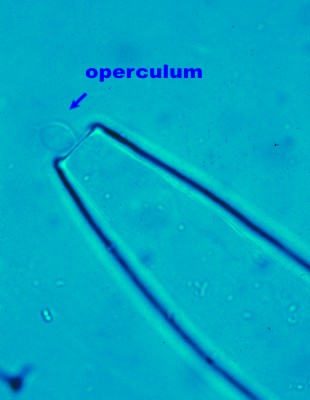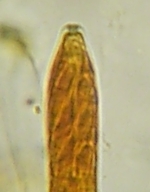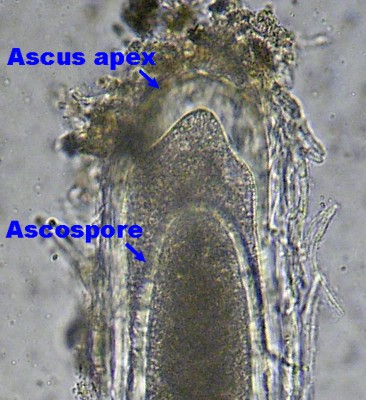DISCUSSION OF THE DISCOMYCETES
Discomycetes produce their asci in apothecia, cup- or dish-shaped structures and, in almost every case, they are easily recognized in the field. Although they are similar to one another on appearance they are produced by three or more unrelated groups of fungi. These are:
Operculate discomycetes (Class: Pezizomycetes)
Inoperculate discomycetes (Class: Leotiomycetes)
Lichenized discomycetes (Class: Lecanoromycetes)

The operculate discomycetes were so-named because of their unique mode of ascus dehiscence. When the ascospores are mature and ready to be discharged a small circular lid at the apex of the ascus pops open. This lid, the operculum, remains attached at one point so that it looks like the top of a tin can that has been entirely opened except for one small point. The photo at left is of Ascobolus stercorarius, a discomycetes commonly found on dung of herbivorous animals. The operculum is not always as easy to see as this one, but this is seldom the cause of much difficulty. Operculate discomycetes usually grow on soil, dung, rotting logs and other materials that are not of very recent or specific plant origin. They can be large and fleshy. The ascospores are always single-celled and have a very strict radial symmetry. They are never curved or bent, nor do they have unequal ends. Most are rather perfect ellipsoids.

The asci of inoperculate discomycetes lack an operculum. Instead the apex of the ascus may be perforated by a pore or a small plug as in the picture of a species of Calycellina at left. The blue colour of the pore is due to it being stained in Lugol's solution, a mixture of water, potassium iodide and iodine. The asci are usually smaller than those of operculate discomycetes. The ascospores of inoperculate discomycetes are not as highly symmetrical as those of the operculate discomycetes and are septate in many species. The apothecia of inoperculate discomycetes are usually quite small. Many inoperculate discomycetes have specific relationships with plants and are found on the living or dead remains of only certain species. Some may cause plant disease, something operculate discomycetes never do.

The lichenized discomycetes have neither an operculum nor an apical pore in their asci. The wall is thick, often clearly composed of two walls and with a relatively undifferentiated thick apex. Ascospores can be one-celled to many-celled, light to dark and with various symmetries. The obvious feature of this group is that they almost all form mutualistic associations with algae to form lichens. The organism in the photo at left is Pertusaria velata, a species that forms its apothecia on a thick gray lichen thallus. It is most commonly found on old sugar maples. In the picture you can see the very thick apex of the ascus and a single ascospore below it.